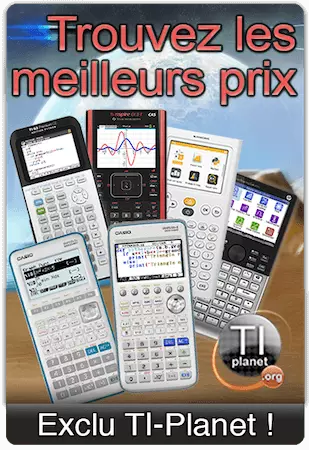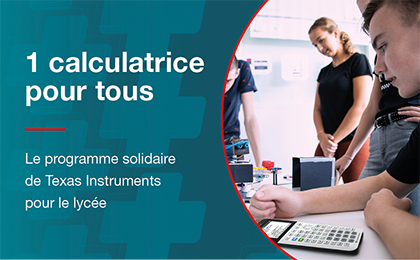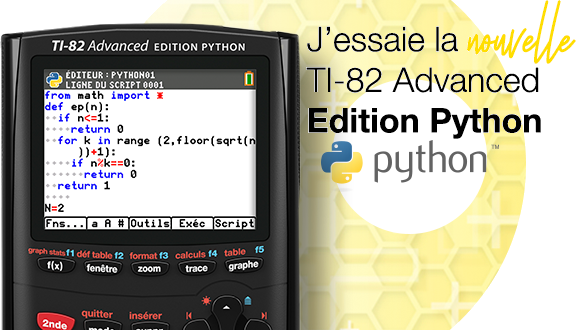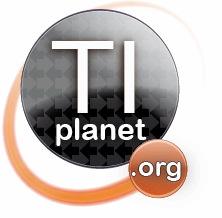Choisir sa calculatrice :
Tableau de comparaison (QCC 2024)
Analyse/Guide complet (QCC 2024)
Tutos mode examen :
Candidats : Activation • Liste modèles conformes
Surveillants : Lancement épreuves • Revalidation
Welcome to TI-Planet, the reference scientific and graphing calculators community !
-

Social TI-Planet
-

Donations / Premium
For more contests, prizes, reviews, helping us pay the server and domains...
Donate
Discover the the advantages of a donor account !
JoinRejoignez the donors and/or premium!les donateurs et/ou premium !
Donate
Discover the the advantages of a donor account !
JoinRejoignez the donors and/or premium!les donateurs et/ou premium !
-

Stats.
1095 utilisateurs:
>1083 invités
>6 membres
>6 robots
>1083 invités
>6 membres
>6 robots
Record simultané (sur 6 mois):
6892 utilisateurs (le 07/06/2017)
6892 utilisateurs (le 07/06/2017)
News
- Catégories
- TI-Nspire
- TI-82 / 83 / 84
- TI-89 / 92 / Voyage 200
- TI Scientifiques
- Casio
- NumWorks
- HP (Moravia)
- Sharp (Moravia)
- Symbolibre, Librecalc
- Lexibook, Truly
- Zero
- Examens - Concours
- Divers
- All news
- Latest news
- Mise à jour émulateurs TI-SmartView CE 6.0.30
[TI-73/76/82/83/84/85/86] (06/04 09:27) - Mise à jour 6.2.2 application TI-Nspire CAS pour iPad82
[TI-Nspire] (04/04 01:19) - Offre Casio familles rentrée 2025 - de 3€ à 14€ remboursés !315
[Casio] (03/04 11:35) - Nvelles coques perso Graph 35+E II avec cagnottes Casio 2025192
[Casio] (02/04 23:14) - Cagnottes Casio 2025 fx92 Graph Light/35/Math+ à petits prix74
[Casio] (02/04 21:27) - Sortie TI-Connect CE 6.0.3277
[TI-73/76/82/83/84/85/86] (02/04 16:35) - Casio fx-1AU Graph approuvée pour le SACE 2026 (Australie)61
[Casio] (02/04 16:09) - Formations Graph Light/Math+ avec posters Women Do Science1809
[Casio] (25/03 21:20) - Emulateur Graph Math+ V2.00 dispo via Casio-Education.eu267
[Casio] (24/03 04:18) - Epreuve de Maths anticipée BAC 2026 sans calculatrice3581
[Examens/Concours] (21/03 00:52)
Programs &
Downloads
- Downloads
- TI-Nspire
- TI-83 Premium CE / 84+CE / 82APy
- TI-82 Advanced / 84+T
- TI-82+ / 83+ / 84+
- TI-76.fr / 82 Stats / 83
- TI-89 / 92 / Voyage 200
- NumWorks
- Casio Graph 25 35 75 85 95
fx-7400/9750/9860 G/GII/GIII - Graph Math+/90+E - fx-CG10/20/50
- Casio fx-CP400/CG500
- HP Prime
- 39gII
- 49/50
- 48
- Selections (Exams, tools, lessons...)
- Upload a file
- My uploaded files
- Latest files
-
Le jeu du pendu
7
[Jeux NumWorks] (Aubinouchouchou) -
Emulateur TI-SmartView CE-T 84 (v. 6.0.3) Mac
5
[Utilitaires Mac TI-83 Premium CE / 84+CE / 82APy] (Texas Instruments) -
Emulateur TI-SmartView CE-T 84 (v. 6.0.3) Windows
7
[Utilitaires PC TI-83 Premium CE / 84+CE / 82APy] (Texas Instruments) -
Emulateur TI-SmartView CE 84 (v. 6.0.3) Windows
6
[Utilitaires PC TI-83 Premium CE / 84+CE / 82APy] (Texas Instruments) -
Emulateur TI-SmartView CE 84 (v. 6.0.3) Mac
6
[Utilitaires Mac TI-83 Premium CE / 84+CE / 82APy] (Texas Instruments) - Latest updates
-
First Fantasy: Mana Force v6.0.2
1742
[Jeux TI-83 Premium CE / 84+CE / 82APy] (DJ Omnimaga) -
Reversi Prime
9
[Jeux HP-Prime] (Piotr Kowalewski) -
CERMASTR
3361
[Utilitaires TI-83 Premium CE / 84+CE / 82APy] (Xavier Andréani) -
Plateforme
24
[Jeux NumWorks] (dkfe123)
- Popular files
-
Oiram CE (mario-like)
661
[Jeux TI-83 Premium CE / 84+CE / 82APy] (MateoConLechuga) -
Geometry Dash CE
642
[Jeux TI-83 Premium CE / 84+CE / 82APy] (Epharius) -
PacMan CE
507
[Jeux TI-83 Premium CE / 84+CE / 82APy] (MateoConLechuga) -
Flappy bird color
446
[Jeux Casio Graph Math+/90+E/fx-CG] (Lancelot) -
Mario Kart CE
430
[Jeux TI-83 Premium CE / 84+CE / 82APy] (tr1p1ea) -
FlappyBird
415
[Jeux TI-83 Premium CE / 84+CE / 82APy] (Rico) -
CGDoom fx-CG50 / Graph 90+E
330
[Jeux Casio Graph Math+/90+E/fx-CG] (Lephenixnoir) -
Snake
318
[Jeux NumWorks] (Golem64) -
Doom (Shareware)
286
[Jeux Doom Casio Graph Math+/90+E/fx-CG] (Id Software) -
Jetpack-Bird
257
[Jeux NumWorks] (Fime)
Converters
- Latest converted documents
- examens espace
[mViewer GX Creator App HP-Prime] (MattiasBelche) - exercices espace
[mViewer GX Creator App HP-Prime] (MattiasBelche) - interros espace
[mViewer GX Creator App HP-Prime] (MattiasBelche) - Texas Guide 3
[mViewer GX Creator Lua TI-Nspire] (clark sanders) - Texas Guide 1
[mViewer GX Creator Lua TI-Nspire] (clark sanders) - Texas Guide 2
[mViewer GX Creator Lua TI-Nspire] (clark sanders) - Texas Guide 1
[mViewer GX Creator Lua TI-Nspire] (clark sanders) - CCCCCCCC8
[mViewer GX Creator Lua TI-Nspire] (r.g) - CCCCCCCC7
[mViewer GX Creator Lua TI-Nspire] (r.g) - CCCCCCCC7
[mViewer GX Creator Lua TI-Nspire] (r.g)
Forum
- Catégories
- TI-Nspire
- TI-82 / 83 / 84
- TI-89 / 92 / Voyage 200
- TI Scientifiques
- Casio
- NumWorks
- HP
- Divers
- Quick links
- All forums
- Topics of the last 7 days
- Unanswered messages
- Unread messages
- Messages since last visit
- Latest posts
- Mise à jour émulateurs TI-SmartView CE 6.0.30
critor (06/04/2025 09:27) - Re: Je ne sais pas utiliser nLoader pour dégrader mon TI-nsp148
CALCFurina (06/04/2025 00:09) - Re: Sortie TI-Connect CE 6.0.3277
tiGEEK (05/04/2025 21:30) - Re: Le problème de la durée de la recharge des NumWorks357
cent20 (05/04/2025 09:36) - Re: Le jeu WHIS sur la Casio Graph 90+E1645
Afyu (04/04/2025 19:47) - Re: [ Aide ] C ou Lua Dimension103
qzeddqdqdqsd (04/04/2025 18:18) - Mise à jour 6.2.2 application TI-Nspire CAS pour iPad82
critor (04/04/2025 01:19) - Re: Epreuve de Maths anticipée BAC 2026 sans calculatrice3581
Noury (03/04/2025 22:24) - Offre Casio familles rentrée 2025 - de 3€ à 14€ remboursés !315
critor (03/04/2025 11:35) - Re: Nvelles coques perso Graph 35+E II avec cagnottes Casio 192
critor (03/04/2025 10:09)
Gallery
- Latest picture
-
Coque Galaxy Graph 35+E II
[Généralités Casio]
© 2011-2025 TI-Planet.
Website managed by UPECS non-profit organization. See our privacy policy.
The proper functioning of TI-Planet relies on cookies. You can configure (and consent to) the usage of optional cookies.
SmartNav : Off (ON = connexion nécessaireON = login required)
Nous ne pouvons pas forcément surveiller l'intégralité du contenu publié par nos membres - n'hésitez pas à nous contacter si besoinWe may not be able to review all the content published by our members - do not hesitate to contact us if needed (info[at]tiplanet[.]org).
Forum powered by phpBB © phpBB Group — Traduction phpBB par phpBB-fr — Some icons from FatCow
The proper functioning of TI-Planet relies on cookies. You can configure (and consent to) the usage of optional cookies.
SmartNav : Off (ON = connexion nécessaireON = login required)
Nous ne pouvons pas forcément surveiller l'intégralité du contenu publié par nos membres - n'hésitez pas à nous contacter si besoinWe may not be able to review all the content published by our members - do not hesitate to contact us if needed (info[at]tiplanet[.]org).
Forum powered by phpBB © phpBB Group — Traduction phpBB par phpBB-fr — Some icons from FatCow














